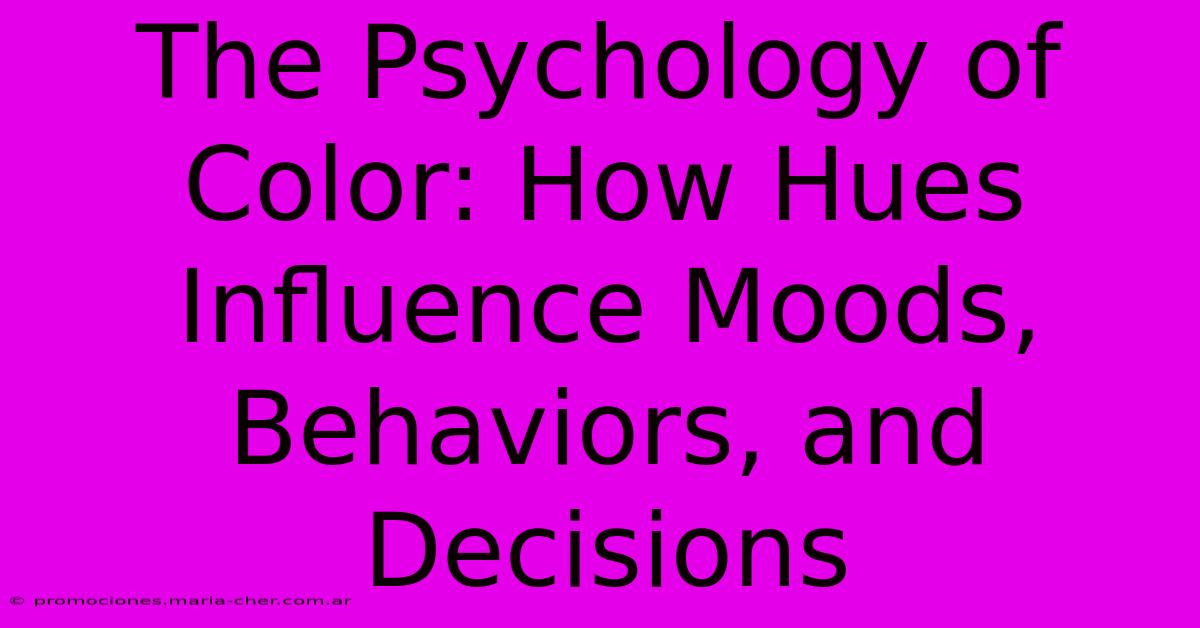The Psychology Of Color: How Hues Influence Moods, Behaviors, And Decisions

Table of Contents
The Psychology of Color: How Hues Influence Moods, Behaviors, and Decisions
Color is more than just a visual element; it's a powerful psychological tool that subtly influences our moods, behaviors, and even the decisions we make. Understanding the psychology of color can be invaluable for marketers, designers, and anyone seeking to create impactful experiences. This article delves into the fascinating world of color psychology, exploring how different hues affect us and how this knowledge can be leveraged effectively.
The Emotional Impact of Colors
Different colors evoke distinct emotional responses. These responses are often rooted in cultural associations and personal experiences, but some general trends emerge:
Warm Colors: Energy and Excitement
-
Red: Often associated with passion, energy, excitement, and urgency. It can also stimulate appetite, making it a popular choice for restaurants. However, overuse can lead to feelings of aggression or anxiety. Think of stop signs – red immediately commands attention and evokes a sense of caution.
-
Orange: A vibrant and energetic color, orange evokes feelings of enthusiasm, creativity, and warmth. It's often used to create a friendly and approachable atmosphere.
-
Yellow: Represents happiness, optimism, and intelligence. It can be stimulating, but excessive yellow can be overwhelming and even irritating.
Cool Colors: Calm and Serenity
-
Blue: Often associated with peace, tranquility, trust, and stability. It's frequently used in corporate settings to convey professionalism and reliability. Different shades of blue evoke different feelings; darker blues can feel more sophisticated, while lighter blues feel more calming.
-
Green: Symbolizes nature, growth, and harmony. It's often associated with health, freshness, and renewal. Green is generally calming and promotes a sense of well-being.
-
Purple: A color of royalty and luxury, purple often evokes feelings of creativity, wisdom, and mystery. It can be both calming and stimulating, depending on the shade.
Neutral Colors: Balance and Sophistication
-
White: Represents purity, cleanliness, and simplicity. It can create a feeling of spaciousness and serenity, but excessive white can feel sterile.
-
Black: Associated with power, elegance, and sophistication. It can be mysterious and even intimidating, but it also represents authority and control.
-
Gray: Neutral and versatile, gray often conveys a sense of balance, stability, and formality. It can be sophisticated and calming, but too much gray can feel dull or depressing.
Color Psychology in Marketing and Design
Understanding color psychology is crucial for effective marketing and design. By using colors strategically, businesses can:
- Increase brand recognition: Consistent use of brand colors helps build familiarity and recognition.
- Influence consumer behavior: Colors can influence purchasing decisions; for example, using red can create a sense of urgency, prompting impulse buys.
- Create a specific mood or atmosphere: Choosing appropriate colors can set the tone for a website, store, or advertisement.
- Improve website usability: Color can be used to guide users' eyes and highlight important information.
Beyond the Basics: Cultural Considerations
It's important to remember that color associations are not universal. Cultural differences play a significant role in how colors are perceived. For example, while white is associated with purity in Western cultures, it represents mourning in some Eastern cultures. Therefore, it's crucial to consider your target audience's cultural background when selecting colors for marketing or design purposes.
Conclusion: Harnessing the Power of Color
The psychology of color is a complex and fascinating field. By understanding how different colors impact our emotions and behaviors, we can leverage their power to create more effective marketing campaigns, enhance design aesthetics, and build stronger brands. Remember to consider cultural nuances and always test your color choices to ensure they resonate with your intended audience. The thoughtful use of color can dramatically enhance communication and create truly impactful experiences.

Thank you for visiting our website wich cover about The Psychology Of Color: How Hues Influence Moods, Behaviors, And Decisions. We hope the information provided has been useful to you. Feel free to contact us if you have any questions or need further assistance. See you next time and dont miss to bookmark.
Featured Posts
-
Unveiling The Wholesale Wonder Babys Breath Paradise Revealed
Feb 08, 2025
-
Ambers Radiant Radiance Discover The Allure Of Golden Yellow Roses
Feb 08, 2025
-
Behind The Lens The Transformative Power Of Photographer Selfies
Feb 08, 2025
-
From Classic To Chic Transformation Guide For Hot Pink Floral Bouquets For Every Wedding Theme
Feb 08, 2025
-
Unlock The Secrets A Beginners Guide To Floral Tape Mastery
Feb 08, 2025
